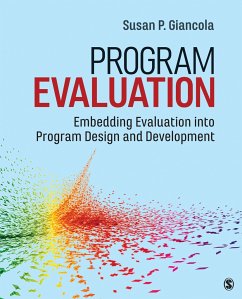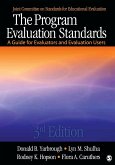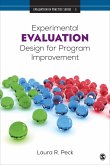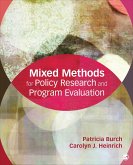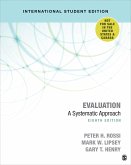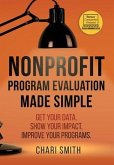- Broschiertes Buch
- Merkliste
- Auf die Merkliste
- Bewerten Bewerten
- Teilen
- Produkt teilen
- Produkterinnerung
- Produkterinnerung
Program Evaluation: Embedding Evaluation into Program Design and Development provides an in-depth examination of the foundations, methods, and relevant issues in the field of evaluation. With an emphasis on an embedded approach, where evaluation is an explicit part of a program that leads to the refinement of the program, students will learn how to conduct effective evaluations that foster continual improvement and enable data-based decision making.
Andere Kunden interessierten sich auch für
![The Program Evaluation Standards The Program Evaluation Standards]() Donald B. YarbroughThe Program Evaluation Standards90,99 €
Donald B. YarbroughThe Program Evaluation Standards90,99 €![Experimental Evaluation Design for Program Improvement Experimental Evaluation Design for Program Improvement]() Laura R. PeckExperimental Evaluation Design for Program Improvement54,99 €
Laura R. PeckExperimental Evaluation Design for Program Improvement54,99 €![Mixed Methods for Policy Research and Program Evaluation Mixed Methods for Policy Research and Program Evaluation]() Patricia E. BurchMixed Methods for Policy Research and Program Evaluation114,99 €
Patricia E. BurchMixed Methods for Policy Research and Program Evaluation114,99 €![Evaluation - International Student Edition Evaluation - International Student Edition]() Peter H. RossiEvaluation - International Student Edition153,99 €
Peter H. RossiEvaluation - International Student Edition153,99 €![Program Evaluation Program Evaluation]() Arlene FinkProgram Evaluation50,99 €
Arlene FinkProgram Evaluation50,99 €![Nonprofit Program Evaluation Made Simple Nonprofit Program Evaluation Made Simple]() Chari SmithNonprofit Program Evaluation Made Simple38,99 €
Chari SmithNonprofit Program Evaluation Made Simple38,99 €![Statistics for People Who (Think They) Hate Statistics - International Student Edition Statistics for People Who (Think They) Hate Statistics - International Student Edition]() Neil J. SalkindStatistics for People Who (Think They) Hate Statistics - International Student Edition153,99 €
Neil J. SalkindStatistics for People Who (Think They) Hate Statistics - International Student Edition153,99 €-
-
-
Program Evaluation: Embedding Evaluation into Program Design and Development provides an in-depth examination of the foundations, methods, and relevant issues in the field of evaluation. With an emphasis on an embedded approach, where evaluation is an explicit part of a program that leads to the refinement of the program, students will learn how to conduct effective evaluations that foster continual improvement and enable data-based decision making.
Hinweis: Dieser Artikel kann nur an eine deutsche Lieferadresse ausgeliefert werden.
Hinweis: Dieser Artikel kann nur an eine deutsche Lieferadresse ausgeliefert werden.
Produktdetails
- Produktdetails
- Verlag: SAGE Publications Inc
- Seitenzahl: 432
- Erscheinungstermin: 1. Mai 2020
- Englisch
- Abmessung: 227mm x 183mm x 25mm
- Gewicht: 786g
- ISBN-13: 9781506357447
- ISBN-10: 150635744X
- Artikelnr.: 57361998
- Herstellerkennzeichnung
- Libri GmbH
- Europaallee 1
- 36244 Bad Hersfeld
- gpsr@libri.de
- Verlag: SAGE Publications Inc
- Seitenzahl: 432
- Erscheinungstermin: 1. Mai 2020
- Englisch
- Abmessung: 227mm x 183mm x 25mm
- Gewicht: 786g
- ISBN-13: 9781506357447
- ISBN-10: 150635744X
- Artikelnr.: 57361998
- Herstellerkennzeichnung
- Libri GmbH
- Europaallee 1
- 36244 Bad Hersfeld
- gpsr@libri.de
Sue Giancola, Ph.D. has over 20 years of experience as an evaluator in both academia and private business. Prior to becoming an evaluator, she worked in corporate and higher education settings on process improvement initiatives. Dr. Giancola is a graduate of the University of Pennsylvania's Policy Research, Evaluation, and Measurement program. She also has a bachelor's degree from the University of Virginia in systems engineering and a master's degree from Pennsylvania State University in management. She is currently Senior Associate Director of the Center for Research in Education and Social Policy (CRESP) at the University of Delaware. Her work focuses on research and evaluation of programs to improve human services, primarily in the areas of education and health. She evaluates many local, state, and federal initiatives, including projects funded through NIH, NSF, U.S. Department of Health and Human Services, and U.S. Department of Education. Dr. Giancola is a member of the American Evaluation Association and the American Educational Research Association. She lives in Kennett Square, Pennsylvania with her husband and two daughters.
Acknowledgments Preface About the Author SECTION I
INTRODUCTION Chapter 1
Evaluation Matters 1.1 What Is Evaluation? 1.2 Why Evaluate? 1.3 Values and Standards in Evaluation 1.4 Types of Evaluation 1.5 Internal and External Evaluation 1.6 Embedding Evaluation Into Programs 1.7 Textbook Organization 1.8 Chapter Summary Reflection and Application Chapter 2
History of Evaluation 2.1 The Evolution of Evaluation 2.2 The History of Ethics in Research and Evaluation 2.3 Current Issues in Evaluation 2.4 Chapter Summary Reflection and Application Chapter 3
Evaluation Ethics 3.1 Ethics Defined 3.2 Research Ethics Guidelines and Legislation 3.3 IRB Protocols and Amendments 3.4 Ethical Responsibilities of Organizations 3.5 Ethical Responsibilities of Evaluators 3.6 Additional Considerations 3.7 Chapter Summary Reflection and Application Chapter 4
Evaluation Ideologies and Approaches 4.1 Inquiry and Ideology 4.2 Evaluation Ideology 4.3 Evaluation Design 4.4 Evaluation Approach 4.5 Embedded Evaluation 4.6 Chapter Summary Reflection and Application SECTION II
EMBEDDED EVALUATION: DESIGN Chapter 5
DEFINE, Part 1: Understanding the Program 5.1 Embedded Evaluation 5.2 Understanding the Program 5.3 Delineating Goals and Strategies 5.4 Explaining the Program Theory 5.5 Determining Contextual Conditions 5.6 Program Theory and Other Theories 5.7 Considering Alternative Theories 5.8 Chapter Summary Reflection and Application Chapter 6
DEFINE, Part 2: Modeling the Program 6.1 Chapter in Context 6.2 What Is a Logic Model? 6.3 Creating the Logic Model 6.4 Using the Program's Logic Model 6.5 More on Logic Models 6.6 Chapter Summary Reflection and Application Chapter 7
PLAN, Part 1: Planning the Evaluation 7.1 Creating Evaluation Questions 7.2 Embedding Evaluation Questions Into Your Logic Model 7.3 What Data Should I Collect? 7.4 Creating the Evaluation Matrix 7.5 Chapter Summary Reflection and Application Chapter 8
PLAN, Part 2: Designing the Evaluation 8.1 Evaluation Design 8.2 Evaluation Methods and Tools 8.3 Evaluation Matrix: Identifying Data Sources 8.4 Chapter Summary Reflection and Application SECTION III
EMBEDDED EVALUATION: IMPLEMENTATION Chapter 9
IMPLEMENT, Part 1: Implementing the Evaluation 9.1 Chapter in Context 9.2 Informed Consent 9.3 Collecting the Data 9.4 Organizing Quantitative Data 9.5 Organizing Qualitative Data 9.6 Chapter Summary Reflection and Application Chapter 10
IMPLEMENT, Part 2: Analyzing the Data 10.1 Chapter in Context 10.2 Quantitative Data Analysis: Descriptive Statistics 10.3 Quantitative Data Analysis: Inferential Statistics 10.4 Qualitative Data Analysis 10.5 Managing the Unexpected and Unintended 10.6 Chapter Summary Reflection and Application Chapter 11
INTERPRET: Interpreting the Results 11.1 The Home Stretch 11.2 Examining Results 11.3 Interpreting Results 11.4 Communicating Evaluation Results 11.5 Enhancing Reporting and Communication 11.6 Chapter Summary Reflection and Application Chapter 12
INFORM and REFINE: Using Evaluation Results 12.1 Purpose of Evaluation 12.2 Pre-Evaluation: Efforts to Promote Utilization 12.3 During Evaluation: Ongoing Utilization Efforts 12.4 Post-Evaluation and Data Dissemination 12.5 Chapter Summary Reflection and Application SECTION IV
RESOURCES Chapter 13
Case Study Applications 13.1 LEND Evaluation 13.2 ACCEL Evaluation 13.3 YAP Evaluation Appendices: Special Topics Appendix A: Needs Assessment Appendix B: Politics and Policy Appendix C: Developmental Evaluation Appendix D: Translational Research Evaluation Glossary References Index
INTRODUCTION Chapter 1
Evaluation Matters 1.1 What Is Evaluation? 1.2 Why Evaluate? 1.3 Values and Standards in Evaluation 1.4 Types of Evaluation 1.5 Internal and External Evaluation 1.6 Embedding Evaluation Into Programs 1.7 Textbook Organization 1.8 Chapter Summary Reflection and Application Chapter 2
History of Evaluation 2.1 The Evolution of Evaluation 2.2 The History of Ethics in Research and Evaluation 2.3 Current Issues in Evaluation 2.4 Chapter Summary Reflection and Application Chapter 3
Evaluation Ethics 3.1 Ethics Defined 3.2 Research Ethics Guidelines and Legislation 3.3 IRB Protocols and Amendments 3.4 Ethical Responsibilities of Organizations 3.5 Ethical Responsibilities of Evaluators 3.6 Additional Considerations 3.7 Chapter Summary Reflection and Application Chapter 4
Evaluation Ideologies and Approaches 4.1 Inquiry and Ideology 4.2 Evaluation Ideology 4.3 Evaluation Design 4.4 Evaluation Approach 4.5 Embedded Evaluation 4.6 Chapter Summary Reflection and Application SECTION II
EMBEDDED EVALUATION: DESIGN Chapter 5
DEFINE, Part 1: Understanding the Program 5.1 Embedded Evaluation 5.2 Understanding the Program 5.3 Delineating Goals and Strategies 5.4 Explaining the Program Theory 5.5 Determining Contextual Conditions 5.6 Program Theory and Other Theories 5.7 Considering Alternative Theories 5.8 Chapter Summary Reflection and Application Chapter 6
DEFINE, Part 2: Modeling the Program 6.1 Chapter in Context 6.2 What Is a Logic Model? 6.3 Creating the Logic Model 6.4 Using the Program's Logic Model 6.5 More on Logic Models 6.6 Chapter Summary Reflection and Application Chapter 7
PLAN, Part 1: Planning the Evaluation 7.1 Creating Evaluation Questions 7.2 Embedding Evaluation Questions Into Your Logic Model 7.3 What Data Should I Collect? 7.4 Creating the Evaluation Matrix 7.5 Chapter Summary Reflection and Application Chapter 8
PLAN, Part 2: Designing the Evaluation 8.1 Evaluation Design 8.2 Evaluation Methods and Tools 8.3 Evaluation Matrix: Identifying Data Sources 8.4 Chapter Summary Reflection and Application SECTION III
EMBEDDED EVALUATION: IMPLEMENTATION Chapter 9
IMPLEMENT, Part 1: Implementing the Evaluation 9.1 Chapter in Context 9.2 Informed Consent 9.3 Collecting the Data 9.4 Organizing Quantitative Data 9.5 Organizing Qualitative Data 9.6 Chapter Summary Reflection and Application Chapter 10
IMPLEMENT, Part 2: Analyzing the Data 10.1 Chapter in Context 10.2 Quantitative Data Analysis: Descriptive Statistics 10.3 Quantitative Data Analysis: Inferential Statistics 10.4 Qualitative Data Analysis 10.5 Managing the Unexpected and Unintended 10.6 Chapter Summary Reflection and Application Chapter 11
INTERPRET: Interpreting the Results 11.1 The Home Stretch 11.2 Examining Results 11.3 Interpreting Results 11.4 Communicating Evaluation Results 11.5 Enhancing Reporting and Communication 11.6 Chapter Summary Reflection and Application Chapter 12
INFORM and REFINE: Using Evaluation Results 12.1 Purpose of Evaluation 12.2 Pre-Evaluation: Efforts to Promote Utilization 12.3 During Evaluation: Ongoing Utilization Efforts 12.4 Post-Evaluation and Data Dissemination 12.5 Chapter Summary Reflection and Application SECTION IV
RESOURCES Chapter 13
Case Study Applications 13.1 LEND Evaluation 13.2 ACCEL Evaluation 13.3 YAP Evaluation Appendices: Special Topics Appendix A: Needs Assessment Appendix B: Politics and Policy Appendix C: Developmental Evaluation Appendix D: Translational Research Evaluation Glossary References Index
Acknowledgments Preface About the Author SECTION I
INTRODUCTION Chapter 1
Evaluation Matters 1.1 What Is Evaluation? 1.2 Why Evaluate? 1.3 Values and Standards in Evaluation 1.4 Types of Evaluation 1.5 Internal and External Evaluation 1.6 Embedding Evaluation Into Programs 1.7 Textbook Organization 1.8 Chapter Summary Reflection and Application Chapter 2
History of Evaluation 2.1 The Evolution of Evaluation 2.2 The History of Ethics in Research and Evaluation 2.3 Current Issues in Evaluation 2.4 Chapter Summary Reflection and Application Chapter 3
Evaluation Ethics 3.1 Ethics Defined 3.2 Research Ethics Guidelines and Legislation 3.3 IRB Protocols and Amendments 3.4 Ethical Responsibilities of Organizations 3.5 Ethical Responsibilities of Evaluators 3.6 Additional Considerations 3.7 Chapter Summary Reflection and Application Chapter 4
Evaluation Ideologies and Approaches 4.1 Inquiry and Ideology 4.2 Evaluation Ideology 4.3 Evaluation Design 4.4 Evaluation Approach 4.5 Embedded Evaluation 4.6 Chapter Summary Reflection and Application SECTION II
EMBEDDED EVALUATION: DESIGN Chapter 5
DEFINE, Part 1: Understanding the Program 5.1 Embedded Evaluation 5.2 Understanding the Program 5.3 Delineating Goals and Strategies 5.4 Explaining the Program Theory 5.5 Determining Contextual Conditions 5.6 Program Theory and Other Theories 5.7 Considering Alternative Theories 5.8 Chapter Summary Reflection and Application Chapter 6
DEFINE, Part 2: Modeling the Program 6.1 Chapter in Context 6.2 What Is a Logic Model? 6.3 Creating the Logic Model 6.4 Using the Program's Logic Model 6.5 More on Logic Models 6.6 Chapter Summary Reflection and Application Chapter 7
PLAN, Part 1: Planning the Evaluation 7.1 Creating Evaluation Questions 7.2 Embedding Evaluation Questions Into Your Logic Model 7.3 What Data Should I Collect? 7.4 Creating the Evaluation Matrix 7.5 Chapter Summary Reflection and Application Chapter 8
PLAN, Part 2: Designing the Evaluation 8.1 Evaluation Design 8.2 Evaluation Methods and Tools 8.3 Evaluation Matrix: Identifying Data Sources 8.4 Chapter Summary Reflection and Application SECTION III
EMBEDDED EVALUATION: IMPLEMENTATION Chapter 9
IMPLEMENT, Part 1: Implementing the Evaluation 9.1 Chapter in Context 9.2 Informed Consent 9.3 Collecting the Data 9.4 Organizing Quantitative Data 9.5 Organizing Qualitative Data 9.6 Chapter Summary Reflection and Application Chapter 10
IMPLEMENT, Part 2: Analyzing the Data 10.1 Chapter in Context 10.2 Quantitative Data Analysis: Descriptive Statistics 10.3 Quantitative Data Analysis: Inferential Statistics 10.4 Qualitative Data Analysis 10.5 Managing the Unexpected and Unintended 10.6 Chapter Summary Reflection and Application Chapter 11
INTERPRET: Interpreting the Results 11.1 The Home Stretch 11.2 Examining Results 11.3 Interpreting Results 11.4 Communicating Evaluation Results 11.5 Enhancing Reporting and Communication 11.6 Chapter Summary Reflection and Application Chapter 12
INFORM and REFINE: Using Evaluation Results 12.1 Purpose of Evaluation 12.2 Pre-Evaluation: Efforts to Promote Utilization 12.3 During Evaluation: Ongoing Utilization Efforts 12.4 Post-Evaluation and Data Dissemination 12.5 Chapter Summary Reflection and Application SECTION IV
RESOURCES Chapter 13
Case Study Applications 13.1 LEND Evaluation 13.2 ACCEL Evaluation 13.3 YAP Evaluation Appendices: Special Topics Appendix A: Needs Assessment Appendix B: Politics and Policy Appendix C: Developmental Evaluation Appendix D: Translational Research Evaluation Glossary References Index
INTRODUCTION Chapter 1
Evaluation Matters 1.1 What Is Evaluation? 1.2 Why Evaluate? 1.3 Values and Standards in Evaluation 1.4 Types of Evaluation 1.5 Internal and External Evaluation 1.6 Embedding Evaluation Into Programs 1.7 Textbook Organization 1.8 Chapter Summary Reflection and Application Chapter 2
History of Evaluation 2.1 The Evolution of Evaluation 2.2 The History of Ethics in Research and Evaluation 2.3 Current Issues in Evaluation 2.4 Chapter Summary Reflection and Application Chapter 3
Evaluation Ethics 3.1 Ethics Defined 3.2 Research Ethics Guidelines and Legislation 3.3 IRB Protocols and Amendments 3.4 Ethical Responsibilities of Organizations 3.5 Ethical Responsibilities of Evaluators 3.6 Additional Considerations 3.7 Chapter Summary Reflection and Application Chapter 4
Evaluation Ideologies and Approaches 4.1 Inquiry and Ideology 4.2 Evaluation Ideology 4.3 Evaluation Design 4.4 Evaluation Approach 4.5 Embedded Evaluation 4.6 Chapter Summary Reflection and Application SECTION II
EMBEDDED EVALUATION: DESIGN Chapter 5
DEFINE, Part 1: Understanding the Program 5.1 Embedded Evaluation 5.2 Understanding the Program 5.3 Delineating Goals and Strategies 5.4 Explaining the Program Theory 5.5 Determining Contextual Conditions 5.6 Program Theory and Other Theories 5.7 Considering Alternative Theories 5.8 Chapter Summary Reflection and Application Chapter 6
DEFINE, Part 2: Modeling the Program 6.1 Chapter in Context 6.2 What Is a Logic Model? 6.3 Creating the Logic Model 6.4 Using the Program's Logic Model 6.5 More on Logic Models 6.6 Chapter Summary Reflection and Application Chapter 7
PLAN, Part 1: Planning the Evaluation 7.1 Creating Evaluation Questions 7.2 Embedding Evaluation Questions Into Your Logic Model 7.3 What Data Should I Collect? 7.4 Creating the Evaluation Matrix 7.5 Chapter Summary Reflection and Application Chapter 8
PLAN, Part 2: Designing the Evaluation 8.1 Evaluation Design 8.2 Evaluation Methods and Tools 8.3 Evaluation Matrix: Identifying Data Sources 8.4 Chapter Summary Reflection and Application SECTION III
EMBEDDED EVALUATION: IMPLEMENTATION Chapter 9
IMPLEMENT, Part 1: Implementing the Evaluation 9.1 Chapter in Context 9.2 Informed Consent 9.3 Collecting the Data 9.4 Organizing Quantitative Data 9.5 Organizing Qualitative Data 9.6 Chapter Summary Reflection and Application Chapter 10
IMPLEMENT, Part 2: Analyzing the Data 10.1 Chapter in Context 10.2 Quantitative Data Analysis: Descriptive Statistics 10.3 Quantitative Data Analysis: Inferential Statistics 10.4 Qualitative Data Analysis 10.5 Managing the Unexpected and Unintended 10.6 Chapter Summary Reflection and Application Chapter 11
INTERPRET: Interpreting the Results 11.1 The Home Stretch 11.2 Examining Results 11.3 Interpreting Results 11.4 Communicating Evaluation Results 11.5 Enhancing Reporting and Communication 11.6 Chapter Summary Reflection and Application Chapter 12
INFORM and REFINE: Using Evaluation Results 12.1 Purpose of Evaluation 12.2 Pre-Evaluation: Efforts to Promote Utilization 12.3 During Evaluation: Ongoing Utilization Efforts 12.4 Post-Evaluation and Data Dissemination 12.5 Chapter Summary Reflection and Application SECTION IV
RESOURCES Chapter 13
Case Study Applications 13.1 LEND Evaluation 13.2 ACCEL Evaluation 13.3 YAP Evaluation Appendices: Special Topics Appendix A: Needs Assessment Appendix B: Politics and Policy Appendix C: Developmental Evaluation Appendix D: Translational Research Evaluation Glossary References Index

